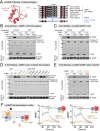This is a preprint.
Dissecting the molecular basis for the modulation of neurotransmitter GPCR signaling by GINIP
- PMID: 37131787
- PMCID: PMC10153262
- DOI: 10.1101/2023.04.20.537566
Dissecting the molecular basis for the modulation of neurotransmitter GPCR signaling by GINIP
Update in
-
Dissecting the molecular basis for the modulation of neurotransmitter GPCR signaling by GINIP.Structure. 2024 Jan 4;32(1):47-59.e7. doi: 10.1016/j.str.2023.10.010. Epub 2023 Nov 20. Structure. 2024. PMID: 37989308 Free PMC article.
Abstract
It is well-established that activation of heterotrimeric G-proteins (Gαβγ) by G-protein-coupled receptors (GPCRs) stimulated by neurotransmitters is a key mechanism underlying neuromodulation. Much less is known about how G-protein regulation after receptor-mediated activation contributes to neuromodulation. Recent evidence indicates that the neuronal protein GINIP shapes GPCR inhibitory neuromodulation via a unique mechanism of G-protein regulation that controls neurological processes like pain and seizure susceptibility. However, the molecular basis of this mechanism remains ill-defined because the structural determinants of GINIP responsible for binding Gαi subunits and regulating G-protein signaling are not known. Here, we combined hydrogen-deuterium exchange mass-spectrometry, protein folding predictions, bioluminescence resonance energy transfer assays, and biochemical experiments to identify the first loop of the PHD domain of GINIP as an obligatory requirement for Gαi binding. Surprisingly, our results support a model in which GINIP undergoes a long-range conformational change to accommodate Gαi binding to this loop. Using cell-based assays, we demonstrate that specific amino acids in the first loop of the PHD domain are essential for the regulation of Gαi-GTP and free Gβγ signaling upon neurotransmitter GPCR stimulation. In summary, these findings shed light onto the molecular basis for a post-receptor mechanism of G-protein regulation that fine-tunes inhibitory neuromodulation.
Conflict of interest statement
CONFLICT OF INTEREST: The authors declare that they have no conflicts of interest with the contents of this article.
Figures







References
-
- Anderson G.R., Cao Y., Davidson S., Truong H.V., Pravetoni M., Thomas M.J., Wickman K., Giesler G.J. Jr., and Martemyanov K.A. (2010). R7BP complexes with RGS9–2 and RGS7 in the striatum differentially control motor learning and locomotor responses to cocaine. Neuropsychopharmacology : official publication of the American College of Neuropsychopharmacology 35, 1040–1050. - PMC - PubMed
-
- Berman D.M., Wilkie T.M., and Gilman A.G. (1996). GAIP and RGS4 are GTPase-activating proteins for the Gi subfamily of G protein alpha subunits. Cell 86, 445–452. - PubMed
-
- Bylund D.B., Eikenberg D.C., Hieble J.P., Langer S.Z., Lefkowitz R.J., Minneman K.P., Molinoff P.B., Ruffolo R.R. Jr., and Trendelenburg U. (1994). International Union of Pharmacology nomenclature of adrenoceptors. Pharmacological reviews 46, 121–136. - PubMed
Publication types
Grants and funding
LinkOut - more resources
Full Text Sources
